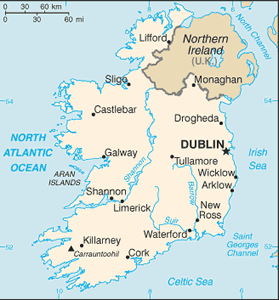The Geography of Ireland
The Geography of Ireland
Irish Geography
Location: Western Europe, occupying five-sixths of the island of Ireland in the North Atlantic Ocean, west of Great Britain
Geographic coordinates: 53 00 N, 8 00 W
Map references: Europe
Area: total: 70,280 sq km land: 68,890 sq km water: 1,390 sq km
Area - comparative: slightly larger than West Virginia
Land boundaries: total: 360 km border countries: UK 360 km
Coastline: 1,448 km
Maritime claims: territorial sea: 12 nm exclusive fishing zone: 200 nm
Climate: temperate maritime; modified by North Atlantic Current; mild winters, cool summers; consistently humid; overcast about half the time
Terrain: mostly level to rolling interior plain surrounded by rugged hills and low mountains; sea cliffs on west coast
Elevation extremes: lowest point: Atlantic Ocean 0 m highest point: Carrauntoohil 1,041 m
Natural resources: natural gas, peat, copper, lead, zinc, silver, barite, gypsum, limestone, dolomite
Land use: arable land: 16.82% permanent crops: 0.03% other: 83.15% (2005)
Irrigated land: NA
Natural hazards: NA
Environment - current issues: water pollution, especially of lakes, from agricultural runoff
Environment - international agreements: party to: Air Pollution, Air Pollution-Nitrogen Oxides, Air Pollution-Sulfur 94, Biodiversity, Climate Change, Climate Change-Kyoto Protocol, Desertification, Endangered Species, Environmental Modification, Hazardous Wastes, Law of the Sea, Marine Dumping, Ozone Layer Protection, Ship Pollution, Tropical Timber 83, Tropical Timber 94, Wetlands, Whaling signed, but not ratified: Air Pollution-Persistent Organic Pollutants, Marine Life Conservation
Geography - note: strategic location on major air and sea routes between North America and northern Europe; over 40% of the population resides within 100 km of Dublin


